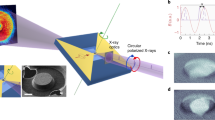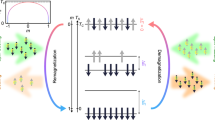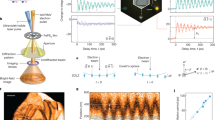Abstract
When excited, the magnetization in a magnet precesses around the field in an anticlockwise manner on a timescale governed by viscous magnetization damping, after which any information carried by the initial actuation seems to be lost. This damping appears to be a fundamental bottleneck for the use of magnets in information processing. However, here we demonstrate the recall of the magnetization-precession phase after times that exceed the damping timescale by two orders of magnitude using dedicated two-colour microwave pump–probe experiments for a Y3Fe5O12 microstructured film. Time-resolved magnetization state tomography confirms the persistent magnetic coherence by revealing a double-exponential decay of magnetization correlation. We attribute persistent magnetic coherence to a feedback effect, that is, coherent coupling of the uniform precession with long-lived excitations at the minima of the spin-wave dispersion relation. Our finding liberates magnetic systems from the strong damping in nanostructures that has limited their use in coherent information storage and processing.
This is a preview of subscription content, access via your institution
Access options
Access Nature and 54 other Nature Portfolio journals
Get Nature+, our best-value online-access subscription
$29.99 / 30 days
cancel any time
Subscribe to this journal
Receive 12 print issues and online access
$259.00 per year
only $21.58 per issue
Buy this article
- Purchase on Springer Link
- Instant access to full article PDF
Prices may be subject to local taxes which are calculated during checkout




Similar content being viewed by others
Data availability
The data that support the findings in this study are available from the corresponding author upon reasonable request.
Code availability
The codes used in the theoretical simulations and calculations are available from the corresponding author upon reasonable request.
References
Landau, L. D. & Lifshitz, L. M. On the theory of the dispersion of magnetic permeability in ferromagnetic bodies. Phys. Z. Sowjetunion 8, 153–169 (1935).
Gilbert, T. L. Lagrangian formulation of the gyromagnetic equation of the magnetization field. Phys. Rev. 100, 1243 (1955).
Rezende, S. M. Fundamentals of Magnonics (Springer Nature, 2020).
Jiao, H. J. & Bauer, G. E. W. Spin backflow and a.c. voltage generation by spin pumping and the inverse spin Hall effect. Phys. Rev. Lett. 110, 217602 (2013).
Hahn, C. et al. Detection of microwave spin pumping using the inverse spin Hall effect. Phys. Rev. Lett. 111, 217204 (2013).
Wei, D., Obstbaum, M., Ribow, M., Back, C. H. & Woltersdorf, G. Spin Hall voltages from a.c. and d.c. spin currents. Nat. Commun. 5, 3768 (2014).
Hyde, P. et al. Electrical detection of direct and alternating spin current injected from a ferromagnetic insulator into a ferromagnetic metal. Phys. Rev. B 89, 180404(R) (2014).
Weiler, M., Shaw, J. M., Nembach, H. T. & Silva, T. J. Phase-sensitive detection of spin pumping via the a.c. inverse spin Hall effect. Phys. Rev. Lett. 113, 157204 (2014).
Tserkovnyak, Y., Brataas, A. & Bauer, G. E. W. Enhanced Gilbert damping in thin ferromagnetic films. Phys. Rev. Lett. 88, 117601 (2002).
Mizukami, S., Ando, Y. & Miyazaki, T. Effect of spin diffusion on Gilbert damping for a very thin permalloy layer in Cu/permalloy/Cu/Pt films. Phys. Rev. B 66, 104413 (2002).
Azevedo, A., Vilela-Leao, L. H., Rodriguez-Suarez, R. L., Oliveira, A. B. & Rezende, S. M. d.c. effect in ferromagnetic resonance: evidence of the spin-pumping effect? J. Appl. Phys. 97, 10C715 (2005).
Saitoh, E., Ueda, M., Miyajima, H. & Tatara, G. Conversion of spin current into charge current at room temperature: inverse spin-Hall effect. Appl. Phys. Lett. 88, 182509 (2006).
Costache, M. V., Sladkov, M., Watts, S. M., van der Wal, C. H. & van Wees, B. J. Electrical detection of spin pumping due to the precessing magnetization of a single ferromagnet. Phys. Rev. Lett. 97, 216603 (2006).
Valenzuela, S. O. & Tinkham, M. Direct electronic measurement of the spin Hall effect. Nature 442, 176–179 (2006).
Kimura, T., Otani, Y., Sato, T., Takahashi, S. & Maekawa, S. Room-temperature reversible spin Hall effect. Phys. Rev. Lett. 98, 156601 (2007).
Kajiwara, Y. et al. Transmission of electrical signals by spin-wave interconversion in a magnetic insulator. Nature 464, 262–266 (2010).
Ando, K. et al. Inverse spin-Hall effect induced by spin pumping in metallic system. J. Appl. Phys. 109, 103913 (2011).
Makiuchi, T. et al. Parametron on magnetic dot: stable and stochastic operation. Appl. Phys. Lett. 118, 022402 (2021).
Shimizu, H., Hioki, T. & Saitoh, E. Numerical study on magnetic parametron under perpendicular excitation. Appl. Phys. Lett. 120, 012402 (2022).
Serga, A. A. et al. Parametrically stimulated recovery of a microwave signal stored in standing spin-wave modes of a magnetic film. Phys. Rev. Lett. 99, 227202 (2007).
Kalinikos, B. A. & Slavin, A. N. Theory of dipole-exchange spin wave spectrum for ferromagnetic films with mixed exchange boundary conditions. J. Phys. C: Solid State Phys. 19, 7013 (1986).
Hurben, M. J. & Patton, C. E. Theory of magnetostatic waves for in-plane magnetized anisotropic films. J. Magn. Magn. Mater. 163, 39–69 (1996).
Damon, R. W. Relaxation effects in the ferromagnetic resonance. Rev. Mod. Phys. 25, 239 (1953).
Bloembergen, N. & Wang, S. Relaxation effects in para- and ferromagnetic resonance. Phys. Rev. 93, 72 (1954).
Rezende, S. M., Azevedo, A., Lucena, M. A. & de Aguiar, F. M. Anomalous spin-wave damping in exchange-biased films. Phys. Rev. B 63, 214418 (2001).
Demidov, V. E. et al. Thermalization of a parametrically driven magnon gas leading to Bose–Einstein condensation. Phys. Rev. Lett. 99, 037205 (2007).
Demidov, V. E. et al. Magnon kinetics and Bose–Einstein condensation studied in phase space. Phys. Rev. Lett. 101, 257201 (2008).
Serga, A. A. et al. Bose–Einstein condensation in an ultra-hot gas of pumped magnons. Nat. Commun. 5, 3452 (2014).
Rückriegel, A., Kopietz, P., Bozhko, D. A., Serga, A. A. & Hillebrands, B. Magnetoelastic modes and lifetime of magnons in thin yttrium iron garnet films. Phys. Rev. B 89, 184413 (2014).
Demokritov, S. O. et al. Bose–Einstein condensation of quasi-equilibrium magnons at room temperature under pumping. Nature 443, 430–433 (2006).
Bozhko, D. et al. Supercurrent in a room-temperature Bose–Einstein magnon condensate. Nat. Phys. 12, 1057–1062 (2016).
Cherepanov, V., Kolokolov, I. & L’vov, V. The saga of YIG: spectra, thermodynamics, interaction and relaxation of magnons in a complex magnet. Phys. Rep. 229, 81 (1993).
Ordóñez-Romero, C. L. et al. Three-magnon splitting and confluence processes for spin-wave excitations in yttrium iron garnet films: wave vector selective Brillouin light scattering measurements and analysis. Phys. Rev. B 79, 144428 (2009).
Cunha, R. O. et al. Nonlinear dynamics of three-magnon process driven by ferromagnetic resonance in yttrium iron garnet. Appl. Phys. Lett. 106, 192403 (2015).
Elyasi, M., Saitoh, E. & Bauer, G. E. W. Stochasticity of the magnon parametron. Phys. Rev. B 105, 054403 (2022).
Hioki, T., Shimizu, H., Makiuchi, T. & Saitoh, E. State tomography for magnetization dynamics. Phys. Rev. B 104, L100419 (2021).
Hillery, M., O’Connell, R. F., Scully, M. O. & Wigner, E. P. Distribution functions in physics: fundamentals. Phys. Rep. 106, 122 (1984).
Leonhardt, U. Measuring the Quantum State of Light (Cambridge Univ. Press, 1997).
Jersch, J. et al. Mapping of localized spin-wave excitations by near-field Brillouin light scattering. Appl. Phys. Lett. 97, 152502 (2010).
Noack, T. B. et al. Evolution of room-temperature magnon gas: toward a coherent Bose–Einstein condensate. Phys. Rev. B 104, L100410 (2021).
Yokoi, N. & Saitoh, E. Intermode depolarization correlation of magnons. Phys. Rev. B 103, 134401 (2021).
Nozue, T. et al. Fabrication of yttrium–iron–garnet/Pt multilayers for the longitudinal spin Seebeck effect. Appl. Phys. Lett. 113, 262402 (2018).
Bunyaev, S. A. et al. Spin-wave relaxation by eddy currents in Y3Fe5O12/Pt bilayers and a way to suppress it. Phys. Rev. Appl. 14, 024094 (2020).
Serha, R. O. et al. Low-damping spin-wave transmission in YIG/Pt-interfaced structures. Adv. Mater. Interfaces 9, 2201323 (2022).
Jungfleisch, M. B. et al. Temporal evolution of inverse spin Hall effect voltage in a magnetic insulator-nonmagnetic metal structure. Appl. Phys. Lett. 99, 182512 (2011).
Guo, F., Belova, L. M. & McMichael, R. D. Parametric pumping of precession modes in ferromagnetic nanodisks. Phys. Rev. B 89, 104422 (2014).
Hahn, E. L. Spin Echoes. Phys. Rev. 80, 580 (1950).
Carr, H. Y. & Purcell, E. M. Effects of diffusion on free precession in nuclear magnetic resonance experiments. Phys. Rev. 94, 630 (1954).
Vansteenkiste, A. et al. The design and verification of MuMax3. AIP Adv. 4, 107133 (2014).
Leliaert, J. et al. Adaptively time stepping the stochastic Landau–Lifshitz–Gilbert equation at nonzero temperature: implementation and validation in MuMax3. AIP Adv. 7, 125010 (2017).
Acknowledgements
We thank T. Kikkawa and S. Daimon for fruitful discussions. This work was partially supported by JST CREST (JPMJCR20C1 and JPMJCR20T2), JST ERATO (JPMJER1402), JST PRESTO (JPMJPR20LB), JSPS KAKENHI (JP26103005, JP19H00645, JP19H05600, JP20K15160, JP21K13847, JP21K13886, JP22K14584, JP22H04965 and JP22H05114), Advanced Technology Institute Research Grants, Institute for AI and Beyond of the University of Tokyo, and IBM–UTokyo Lab. B.H. and A.A.S. acknowledge funding by the Deutsche Forschungsgemeinschaft (DFG, German Research Foundation) via TRR 173/2–268565370 Spin+X.
Author information
Authors and Affiliations
Contributions
T.M., T.H., H.S. and E.S. designed the experiments. T.M. and T.H. prepared the sample. T.M. performed the pump–probe experiments and analysed the data. T.H. and H.S. performed the time-resolved state tomography experiments and analysed the data. K.H. executed the numerical simulations and K.H., T.H. and T.M. analysed the data. M.E., G.E.W.B., K.Y. and E.S. developed the theory. T.M., T.H., H.S., K.H., M.E., K.Y., N.Y., A.A.S., B.H., G.E.W.B. and E.S. discussed the interpretation. E.S. supervised the project. E.S., T.M., T.H., M.E. and G.E.W.B. wrote the paper with input from all authors. All authors discussed the results and contents of the paper.
Corresponding author
Ethics declarations
Competing interests
The authors declare no competing interests.
Peer review
Peer review information
Nature Materials thanks Takis Kontos, and the other, anonymous, reviewer(s) for their contribution to the peer review of this work.
Additional information
Publisher’s note Springer Nature remains neutral with regard to jurisdictional claims in published maps and institutional affiliations.
Extended data
Extended Data Fig. 1 Pump-probe measurement procedure.
a, Microwave circuit. The microwave pulses were made by using signal generators (SGs), radio frequency switches (2 ns rise time) and pulse generators (PGs). The 2f pump and probe pulses were combined, amplified (+35 dB) and filtered (–80 dB at 1f) to eliminate parasitic subharmonic waves at 1f (less than –60 dB). The microwave pulses were injected to the main CPW. The a.c. signal generated from the YIG|Pt disk (grey coloured) was filtered (–80 dB at 2f) to reject crosstalk at 2f, amplified (+35 dB) and combined with an auxiliary microwave to detect the 0/π phase of the a.c. voltage. The 0/π phase measurement by using a signal analyser (SA) was synchronised with the probe pulse. The measurement cycles were repeated a hundred times for each t and θ. We adjusted the input and output microwave phases by using a 100 GS/s real-time oscilloscope. All the microwave instruments (SGs, PGs, SA and oscilloscope) were synchronised with a rubidium frequency standard. For generating FMR pump pulses, the SG in the middle raw (2f, pump) was turned off and the SG in the top raw (1f, bias) was used. b, Pulse sequence generated by the input circuit. c, AC voltage measured with the output circuit.
Extended Data Fig. 2 Microwave circuit for time-resolved tomography measurement.
The microwave pulses for exciting magnetization dynamics were made by using two signal generators (SGs), two radio frequency switches (2 ns rise time), and a pulse generator (PG). The pump pulses were amplified (+35 dB) and filtered (4–8 GHz bandwidth, –80 dB at 1f) to eliminate parasitic subharmonic waves at 1f (less than –60 dB). The pump pulse was combined with a bias pulse at a combiner and injected into the main CPW with the sample, YIG|Pt disk (grey coloured). The a.c. signal generated from the sample was filtered (2.11–2.17 GHz bandwidth, –80 dB at 2f) to reject crosstalk at 2f, and amplified (+35 dB) by using a low-noise HEMT amplifier (LNA). A radio-frequency switch was used to extract the signal within 25 ns. The frequency of the signal was down-converted to δf by using a mixer, and measured using a lock-in amplifier (LIA). We used a 100 GS/s oscilloscope to confirm the measurement circuit function. All the SGs, PG, and LIA were synchronized with a rubidium frequency standard. For the time-resolved state tomography for FMR driving field, we used a boxcar averager function of the LIA.
Extended Data Fig. 3 Persistent coherence in the magnetization dynamics based on the Suhl instability.
Breakdown of different stages of the magnon number \({|{\alpha }_{0(\pm {\mathscr{K}})}|}^{2}\) dynamics for the valley magnons. The dotted vertical lines are characteristic times, viz. tsuhl (Suhl instability kicks in), tsw (parametric excitation is turned off), and td (first stage of the Kittel mode relaxation ends). The dashed-dotted lines indicate single exponential decay at different rates. Here, T = 1 K, P0 = 0.6, Hext = 14 mT, \({\xi }_{\pm\;{\overrightarrow{\,{\mathscr{K}}}}}\) = 0.2 MHz and ξ0 = 2 MHz. The three-magnon confluence exhibits minimal impact on the overall decay rate of the valley magnons (\({|{\alpha }_{\pm {\mathscr{K}}^{\prime} }|}^{2}\)).
Extended Data Fig. 4 Different persistent coherence mechanisms.
a, Examples of \({|{\alpha }_{0}|}^{2}\) dynamics for three main mechanisms of persistent coherence. b, Θ(t) of the condensate based mechanism for several time evolutions from random initial conditions. c, \({\mathscr{P}}(t)\) corresponding to (b).
Extended Data Fig. 5 Persistent coherence with a BEC model.
a, Statistical average of condensate pair phase, \(\langle \text{arg}({c}_{\overrightarrow{{\mathscr{K}}}}{c}_{-\overrightarrow{{\mathscr{K}}}})\rangle\) with and without inclusion of the three-magnon scattering (3MS) with the Kittel mode. b, Θ(t) of the BEC based mechanism for several time evolutions from random initial conditions.
Extended Data Fig. 6 Estimation of lifetime t* from numerical calculation.
a, Temporal evolution of magnetization precession amplitudes calculated from a stochastic Landau–Lifshitz–Gilbert equation. t = 0 is set as the time when the a.c. pumping microwave is turned off. b, A magnified view of a. c, Magnetic field dependence of the magnon decay rate defined as the slope of the calculated precession amplitudes shown in b. The points represent the mean and the error bars indicate the standard deviation obtained from 100 data samples. d, Magnetic field dependence of the magnon lifetime t*. Here, t* is defined as the time at which the precession amplitude decayed to the noise level (Mz/Ms ~ 10–5). The points represent the mean and the error bars indicate the standard deviation obtained from 100 data samples.
Supplementary information
Supplementary Information
Supplementary Sections 1 and 2.
Supplementary Video 1
Temporal evolution of the observed Wigner function during the relaxation process.
Rights and permissions
Springer Nature or its licensor (e.g. a society or other partner) holds exclusive rights to this article under a publishing agreement with the author(s) or other rightsholder(s); author self-archiving of the accepted manuscript version of this article is solely governed by the terms of such publishing agreement and applicable law.
About this article
Cite this article
Makiuchi, T., Hioki, T., Shimizu, H. et al. Persistent magnetic coherence in magnets. Nat. Mater. (2024). https://doi.org/10.1038/s41563-024-01798-z
Received:
Accepted:
Published:
DOI: https://doi.org/10.1038/s41563-024-01798-z



